Written by Lillian
October 11, 2022
Seven weeks have come and gone in a flash. It feels like just yesterday I was trying to learn how to read the train boards in the Metz train station and attempting to locate the GTL shuttle. While many of my friends have studied at GTL before and I’d heard plenty about their experiences, several things have still surprised me during my time here thus far: how early one must rise to reach the train station on time, how heavy a full backpack can weigh on your back, and the rapid five-minute transfers between trains in a flurry with the dozens of others. Balancing classwork and travel has also been more difficult than I anticipated: I feel like I ask myself every week, “Will this be the week I don’t finish my system dynamics homework an hour before the due date?”
In addition to classwork, traveling comes with its own set of growing pains. It gets easier as you learn what to pack, when to leave, what to do, but you also learn more about how naïve you are. Safe travel is important at GTL, and my friends and I have had our share of close scrapes. Throughout the semester, I’ve set more boundaries for myself to avoid these situations. But with new boundaries comes the inevitable fear of missing out. “Should I leave a day early and spend the night in a train station so I can get four more hours in Switzerland? Is it worth it to spend an extra $400 to book plane tickets to Greece?”
Sometimes at GTL, it can feel like other students are experiencing so much more than you and traveling to more countries. For example, one place I knew I wanted to visit before coming to Europe was Switzerland. However, the weekend I visited was wet and rainy, and all other weekends since have been plagued with torrential downpours. I wish I could have traveled earlier and bypassed the rain and while I know hindsight is 20/20, I still sometimes find myself jealous of others who experienced better weather.
To overcome this fear, I remind myself of something that I heard during a talk at a conference: think of everyone like Venn Diagrams. You always want to assume that your circle is within another person’s circle, but in reality, we are intersecting circles. While they may have gone to Denmark, or Great Britain, or even Switzerland and you have not, you have been to Austria, Italy, and Ireland! It always feels like you are the one missing out, but in reality, there are so many experiences that are uniquely yours and yours alone, and I personally would not want to trade my memories of GTL with anyone else’s.
I have been able to travel to so many different countries and experience new surroundings and cultures, and I’ve met so many interesting people. On a train in Germany, the girl sitting next to me was visiting her Aunt in Frankfurt and showed me pictures of her Spanish home. In Amsterdam, I met an American who has been working virtually from abroad since 2020; he’s changed his location every two weeks while staying in hostels all around Europe. In Switzerland, I ran through the train station with a hundred others attempting to catch a train in a four minute transfer. I couldn’t help but laugh out loud as I ran amid the chaos, everyone’s bags flapping behind them. In the lounge of a hostel, my group successfully got over a dozen Europeans to dance the Cotton Eye Joe at midnight; we taught them the steps as we bounced to the song. It’s these situations that make every tight transfer, every midnight homework session, and every early morning train jaunt worth it. I love walking into the student lounge and seeing my friends huddled around a table, ready to go over this week’s homework in preparation for this week’s travels. We are all in this crazy situation together, and we all have each other’s backs no matter what happens or where we have visited— GTL’s community is unmatched!

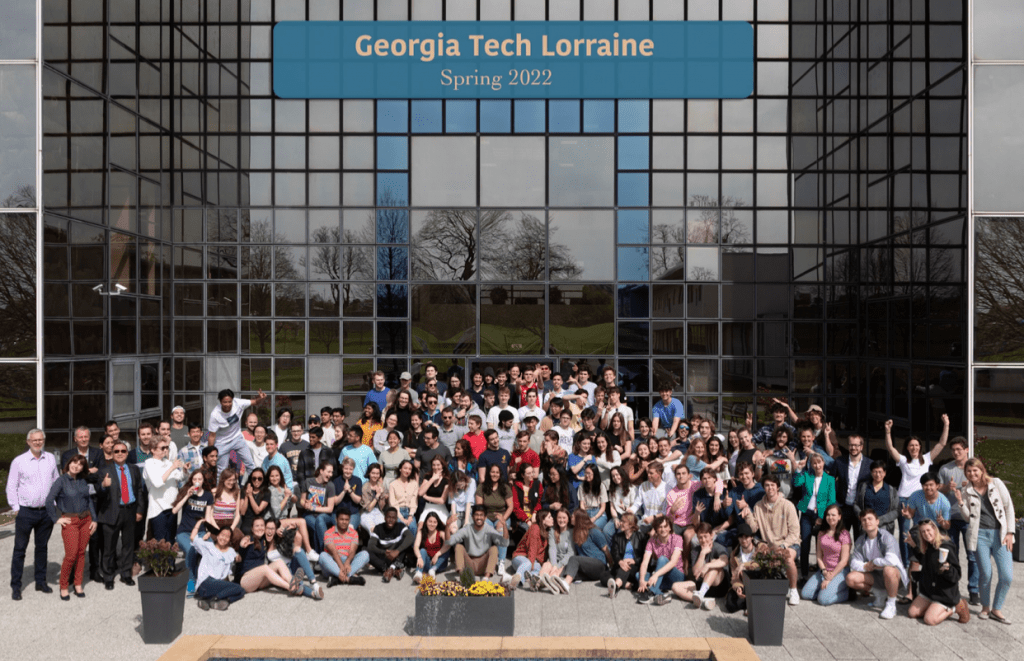

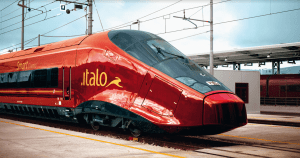

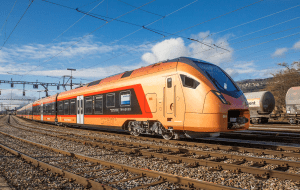
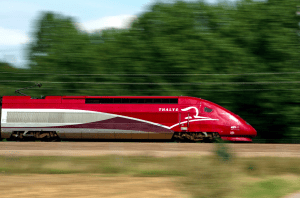
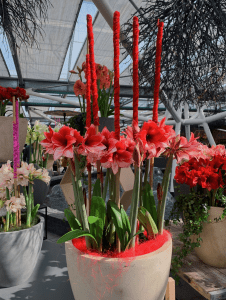 Warmth. As the sun began to filter through the trees, the first signs of Spring emerged as tiny flower buds nestled within the greening grass and started peeking out from the crackly tree branches. In Metz and across Europe, a myriad of colors began to paint the cold, bleak canvas left by winter.
Warmth. As the sun began to filter through the trees, the first signs of Spring emerged as tiny flower buds nestled within the greening grass and started peeking out from the crackly tree branches. In Metz and across Europe, a myriad of colors began to paint the cold, bleak canvas left by winter. 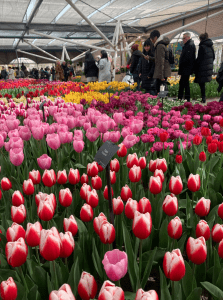
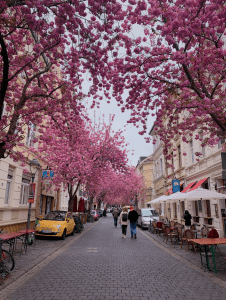 This glorious stretch of cherry blossom was just a random find when we visited Bonn, Germany.
This glorious stretch of cherry blossom was just a random find when we visited Bonn, Germany. 

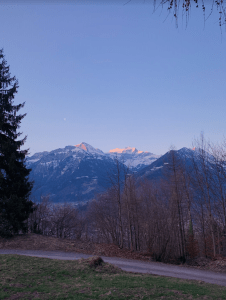 At first, our journey was smooth, we were able to catch a glimpse of the beautiful sunrise as it shimmered across the lake and reflected off the snow-covered mountains across from us. Preparation wise: we really loaded up on food. With 3L of water for each of us, a dozen or so ham sandwiches, 12 granola bars, a pack of Biscoff, 2 fruit squeezies, and a pack of Dutch Nutella cookies, we were set. However, in terms of gear, only one of us had hiking sticks and the rest of us managed to get around using regular school backpacks, tennis shoes, and our overall balance. That was where we made a grave mistake.
At first, our journey was smooth, we were able to catch a glimpse of the beautiful sunrise as it shimmered across the lake and reflected off the snow-covered mountains across from us. Preparation wise: we really loaded up on food. With 3L of water for each of us, a dozen or so ham sandwiches, 12 granola bars, a pack of Biscoff, 2 fruit squeezies, and a pack of Dutch Nutella cookies, we were set. However, in terms of gear, only one of us had hiking sticks and the rest of us managed to get around using regular school backpacks, tennis shoes, and our overall balance. That was where we made a grave mistake. 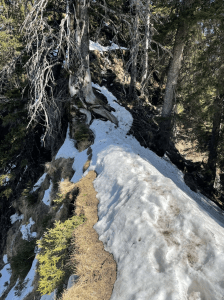 The trails became narrower and the ridge even steeper, with two sharp drops on both sides. We were ill-prepared to take on the trail any longer. When we were almost about the clear the trees, several experienced hikers had turned back, warning us that the ridgeline would be too snowy to continue, but we were determined to check out the scene for ourselves. Long story short- we turned back. The sharp drop was covered in packed, melting snow, the most dangerous combination. With our lack of equipment and expertise, we had to give up the hike. It was just too early in the year to reach Augstmatthorn.
The trails became narrower and the ridge even steeper, with two sharp drops on both sides. We were ill-prepared to take on the trail any longer. When we were almost about the clear the trees, several experienced hikers had turned back, warning us that the ridgeline would be too snowy to continue, but we were determined to check out the scene for ourselves. Long story short- we turned back. The sharp drop was covered in packed, melting snow, the most dangerous combination. With our lack of equipment and expertise, we had to give up the hike. It was just too early in the year to reach Augstmatthorn.  Slowly inching our way down, we were able to scoot slowly over the grass, with one of two terrifying moments when we would lose control over patches of slippery grass, grabbing desperately onto the weeds for some stability. In the end, after 40 miserable minutes of sliding, slipping, and sprawling on the ground to slow our descent, we made it to a flatter ledge on the side. Just getting to the ledge was difficult enough, spreading into a sea star and grabbing the small tree saplings to pull us over to safety. Finally, we had made it. Miraculously, just several meters away was flat ground that looked relatively clear of snow and mud. The trail. Somehow, we had made it to the same trail just further down the mountain, saving us a hundred meters or so of downhill hiking. From there, we hustled down the mountain, almost running as we heard strange animal sounds and breaking branches coming from deep within the forest. After another hour, we collapsed onto the pavement, relieved, exhausted, and elated to be one step closer to home… sike.
Slowly inching our way down, we were able to scoot slowly over the grass, with one of two terrifying moments when we would lose control over patches of slippery grass, grabbing desperately onto the weeds for some stability. In the end, after 40 miserable minutes of sliding, slipping, and sprawling on the ground to slow our descent, we made it to a flatter ledge on the side. Just getting to the ledge was difficult enough, spreading into a sea star and grabbing the small tree saplings to pull us over to safety. Finally, we had made it. Miraculously, just several meters away was flat ground that looked relatively clear of snow and mud. The trail. Somehow, we had made it to the same trail just further down the mountain, saving us a hundred meters or so of downhill hiking. From there, we hustled down the mountain, almost running as we heard strange animal sounds and breaking branches coming from deep within the forest. After another hour, we collapsed onto the pavement, relieved, exhausted, and elated to be one step closer to home… sike.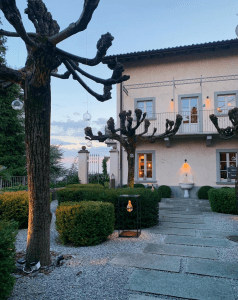 As the sun rose high in the sky, I was delighted to feel the warm rays bathed across my face and the fresh breeze. It was a definite change up from the weather in Metz, where it was perpetually grey and gloomy seven days a week. The city itself was beautiful. The town was lined with colorful houses of pastel orange, yellow, and red. The small little alleyways of the quaint Italian town seemed to emerge from stone, stacked upon each other creating small winding trails on the cliffs above the water, which shimmered a beautiful crystal-turquoise color as small private boats settled on the surface, rocking peacefully back and forth. Although the trees were still on their early spring phase, the leaf-less branches created intricate shapes and patterns that weaved higher in the sky, a natural masterpiece.
As the sun rose high in the sky, I was delighted to feel the warm rays bathed across my face and the fresh breeze. It was a definite change up from the weather in Metz, where it was perpetually grey and gloomy seven days a week. The city itself was beautiful. The town was lined with colorful houses of pastel orange, yellow, and red. The small little alleyways of the quaint Italian town seemed to emerge from stone, stacked upon each other creating small winding trails on the cliffs above the water, which shimmered a beautiful crystal-turquoise color as small private boats settled on the surface, rocking peacefully back and forth. Although the trees were still on their early spring phase, the leaf-less branches created intricate shapes and patterns that weaved higher in the sky, a natural masterpiece. 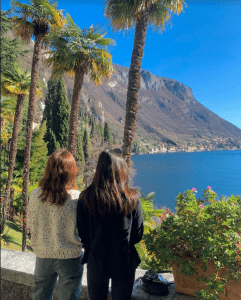
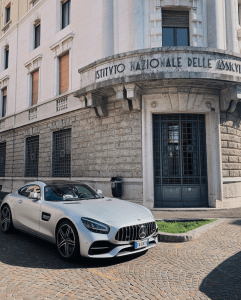 Finally, in Bellagio, we hopped off the ferry right on time to catch the glorious sunset, a ball of bright red that dipped below the horizon. As the sun disappeared, the cold started to set in, coupled with the strong winds that ripped our hair back and forth. As we took a look at the time, we would be right on time to catch the last bus back to the train station in Varenna, which would bring us back to the hotel. We stood in the dark corner of the bus station, waiting as the time ticked past its scheduled arrival. As the moon continued to rise higher into the sky, the bus finally showed up, only to be packed to the BRIM with passengers huddled like sardines on board. There was no room to spare. The driver, however, didn’t even stop; instead, we took one look at our shivering selves at the bus station, shrugged, and sped away. Our hearts sank. There was no way back. We stood there in silence for a minute pondering on what to do, but not too far from the dock, we saw a ferry pulling up to the station. It seemed to be running on schedule despite the strike. At once, we bolted on board only to find twenty other people trying to get to the same train station to catch the next train that would supposedly leave 5 minutes after the ferry arrives.
Finally, in Bellagio, we hopped off the ferry right on time to catch the glorious sunset, a ball of bright red that dipped below the horizon. As the sun disappeared, the cold started to set in, coupled with the strong winds that ripped our hair back and forth. As we took a look at the time, we would be right on time to catch the last bus back to the train station in Varenna, which would bring us back to the hotel. We stood in the dark corner of the bus station, waiting as the time ticked past its scheduled arrival. As the moon continued to rise higher into the sky, the bus finally showed up, only to be packed to the BRIM with passengers huddled like sardines on board. There was no room to spare. The driver, however, didn’t even stop; instead, we took one look at our shivering selves at the bus station, shrugged, and sped away. Our hearts sank. There was no way back. We stood there in silence for a minute pondering on what to do, but not too far from the dock, we saw a ferry pulling up to the station. It seemed to be running on schedule despite the strike. At once, we bolted on board only to find twenty other people trying to get to the same train station to catch the next train that would supposedly leave 5 minutes after the ferry arrives. 
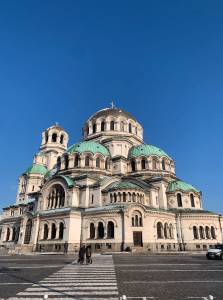 Bulgaria was a place with very rich history and deep national pride. Their cultural norms were rooted for centuries, passed down from family and family. And one of the first influences I noticed was the presence of Eastern Orthodox churches and mosques. Located in the heart of Sofia is St. Alexander’s Basilica. Its brutal architecture featured green and golden domes with large, arche
Bulgaria was a place with very rich history and deep national pride. Their cultural norms were rooted for centuries, passed down from family and family. And one of the first influences I noticed was the presence of Eastern Orthodox churches and mosques. Located in the heart of Sofia is St. Alexander’s Basilica. Its brutal architecture featured green and golden domes with large, arche Inside, the atmosphere was even more unique. As we slowly entered, many Bulgarians would bow at the entrance and before the cross while performing the traditional Catholic crossbody hand gestures. The Basilica itself was very dimly lit with giant chandeliers that hung lowly from the ceiling. Paintings along the walls had darker undertones, featuring a more gothic approach than the fresh rococo style seen in Spain or Italy. There was a priest standing at the front of the sanctuary reading script in worship. His low, melodic yet monotone voice sent shivers down my spine. It was unlike anything I’ve seen or heard before.
Inside, the atmosphere was even more unique. As we slowly entered, many Bulgarians would bow at the entrance and before the cross while performing the traditional Catholic crossbody hand gestures. The Basilica itself was very dimly lit with giant chandeliers that hung lowly from the ceiling. Paintings along the walls had darker undertones, featuring a more gothic approach than the fresh rococo style seen in Spain or Italy. There was a priest standing at the front of the sanctuary reading script in worship. His low, melodic yet monotone voice sent shivers down my spine. It was unlike anything I’ve seen or heard before.
 This is the biggest market in Metz and its definitely one you can’t miss. Basically a Walmart and Target combined into a Costco sized warehouse, Cora is the place to find anything you ever need. There are huge selections of housewares, clothing, pastries, meats, and drinks of all sorts. While prices are not much cheaper than those back in Atlanta, it depends on the meats, fruits, and veggies you end up buying. Tropical fruits, such as strawberries, grapes, and mangos are very expensive, almost 1.5 the price than we usually see at home. Meat cuts include parts from all parts of cows, pigs, and chicken, but the one thing you want to keep in mind when selecting cheaper meat is the date of consumption. Many times, the meats must be eaten within the next 1-3 days, so if you’re traveling on the weekend, it’s best to buy the groceries after you return. Overall, Cora scores a 10/10 on the scale. It has almost everything I ever needed and while it’s a 30-minute walk from Lafayette, with the metro pass, you can get there in a matter of minutes.
This is the biggest market in Metz and its definitely one you can’t miss. Basically a Walmart and Target combined into a Costco sized warehouse, Cora is the place to find anything you ever need. There are huge selections of housewares, clothing, pastries, meats, and drinks of all sorts. While prices are not much cheaper than those back in Atlanta, it depends on the meats, fruits, and veggies you end up buying. Tropical fruits, such as strawberries, grapes, and mangos are very expensive, almost 1.5 the price than we usually see at home. Meat cuts include parts from all parts of cows, pigs, and chicken, but the one thing you want to keep in mind when selecting cheaper meat is the date of consumption. Many times, the meats must be eaten within the next 1-3 days, so if you’re traveling on the weekend, it’s best to buy the groceries after you return. Overall, Cora scores a 10/10 on the scale. It has almost everything I ever needed and while it’s a 30-minute walk from Lafayette, with the metro pass, you can get there in a matter of minutes. 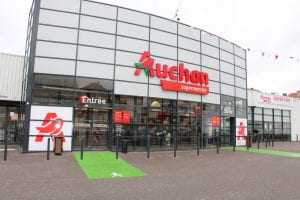 Auchan is a smaller chain supermarket that is closer to Lafayette than Cora. It sells mostly the same things and brands, but overall, Auchan has higher quality pastries and good budget food items. While the veggies selection is not as diverse, it specializes in lot of bio or organic produce that are slightly cheaper than the ones at Cora. From my experience, it is best to go to Auchan earlier in the day when things have been stocked up and when the bakeries just restock on their fresh breads. It scores brownie points for its convenient location and accessibility to Lafayette. Finally, most French groceries stores are highly plastic conscious, so you’ll have to bring your own bags!
Auchan is a smaller chain supermarket that is closer to Lafayette than Cora. It sells mostly the same things and brands, but overall, Auchan has higher quality pastries and good budget food items. While the veggies selection is not as diverse, it specializes in lot of bio or organic produce that are slightly cheaper than the ones at Cora. From my experience, it is best to go to Auchan earlier in the day when things have been stocked up and when the bakeries just restock on their fresh breads. It scores brownie points for its convenient location and accessibility to Lafayette. Finally, most French groceries stores are highly plastic conscious, so you’ll have to bring your own bags! 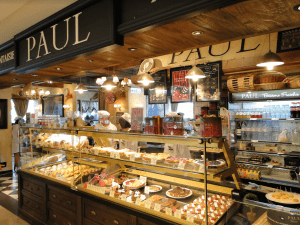 For new French pastry connoisseurs, Paul’s is the perfect place to start exploring. Located just 5 minutes away from GTL, Paul’s has a huge collection of coffees, breads, tarts, and ready-made food just for your convenience. For my first time at Paul’s, I tried their pain au chocolat, a classic French delicacy with chocolate folded into crispy, buttery goodness. Their tarts are amazing with fresh berries and a glaze that isn’t too sweet but also not too sour. Their freshly made baguettes in the morning are perfect for cheese and jam. Overall, the prices are comparable to those in Cora, so you might as well try out what they have and expand your horizons. There are also many tables set up inside for you to get your work done, in an ambient, cozy environment with your favorite pastries. While taste is good, the waiter experience was slightly awkward when we first visited there. If you do not know French, you might want to touch up on some of your basic French phrases before heading over.
For new French pastry connoisseurs, Paul’s is the perfect place to start exploring. Located just 5 minutes away from GTL, Paul’s has a huge collection of coffees, breads, tarts, and ready-made food just for your convenience. For my first time at Paul’s, I tried their pain au chocolat, a classic French delicacy with chocolate folded into crispy, buttery goodness. Their tarts are amazing with fresh berries and a glaze that isn’t too sweet but also not too sour. Their freshly made baguettes in the morning are perfect for cheese and jam. Overall, the prices are comparable to those in Cora, so you might as well try out what they have and expand your horizons. There are also many tables set up inside for you to get your work done, in an ambient, cozy environment with your favorite pastries. While taste is good, the waiter experience was slightly awkward when we first visited there. If you do not know French, you might want to touch up on some of your basic French phrases before heading over. 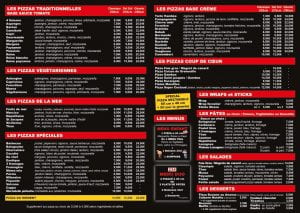 Funny enough, Mamma Mia
Funny enough, Mamma Mia